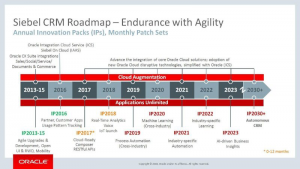Toys“R”Us filed for bankruptcy recently in the wake of big online stores like Amazon stealing their business. It is not just Toys“R”Us. Many other brick-and-mortar stores are closing because of mega-online stores.
This trend can also be found in the in the CRM software market. Per Gartner, statistics show one leader emerging above all: Salesforce. In 2014, it had 18.4% of the market share and is increasing, leaving behind Siebel, Oracle, SAP, Microsoft and other small CRM systems.
Salesforce to other CRM systems is what Amazon is to many brick-and-mortar stores.
So what is wrong with Siebel CRM? Siebel CRM to date has the most robust back end of all CRM software. It provides the most flexibility and supports more vertical businesses than any other CRMs in the market. The biggest drawback it has had is its user interface that has been an issue on several fronts, such as propriety web architecture, ease of use (too many mouse clicks involved), browser dependence, etc.
On-Premise vs SaaS
Something like Siebel is designed for an on-premise server installation (Windows, Unix, Linux). Currently it is not possible to take the heavy architecture and move it to a multi-tenant cloud like Oracle Sales Cloud or SFDC, but it can be migrated from an on-premise installation to a Cloud Infrastructure-As-A-Service like AWS, Azure, Oracle Cloud. Even though the infrastructure can be easily moved to a cloud infrastructure offering, the level of integration Siebel application has to other enterprise systems, has been the stumbling block in doing this effectively. So clients who have invested heavily in Siebel, instead of shelving it, are taking to more innovative approaches like Siebel back end integrated with a web based front end (Java, .net, Siebel OUI, ASP etc). Although there are rumors that Oracle has stopped selling Siebel to new customers and are pushing their Cloud services (Oracle is denying this statement), there are many existing customers who cannot afford to move out of Siebel – either due to the concerns of security of their data or because of the heavy customizations which cannot be accomplished by other cloud applications or due to level of integration their Siebel implementation has with the other enterprise systems.
Future
Per the Oracle Siebel CRM Roadmap, it looks like Oracle is looking at Siebel as a very viable product with a very long road map way into 2030. These bring capabilities such as Cloud-Ready Composer (IP2017), IRM, IoT (IP2018), more integrations to other cloud applications (Oracle, AWS etc) just to list a few. I have personally worked on multiple clients who have switched to Siebel’s new Open UI architecture and are successful and happy with the change. Who knows? Maybe the Open UI architecture is the key change existing Siebel customers need to preserve their investment in the product. I also know clients who just use the Siebel back end/meta data and build an in-house integrated front end.
So, to answer the burning question: I don’t think Siebel is dying but rather being sustained by existing customers who would need to make it a viable investment so they can continue to leverage the promised future functionalities like Open UI, Cloud-Ready composer, RESTful APIs, IoT, AI-driven CRM, etc.
Articles on the current state of the retail industry:
http://money.cnn.com/2017/04/22/news/credit-suisse-retail/index.html
http://www.gartner.com/newsroom/id/3056118
http://www.gartner.com/binaries/content/assets/events/keywords/crm/gartner-crm-predicts.pdf



Hi, i have been working as a full time Siebel Admin past 7 years. I have implemented IP17 and explored new features. But Siebel job market is down and i dont see future working as Siebel Administrator. Can you please suggest the career path admin can choose. Shifting career as AWS cloud admin will help ?